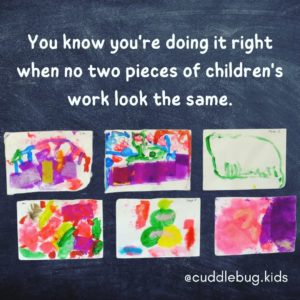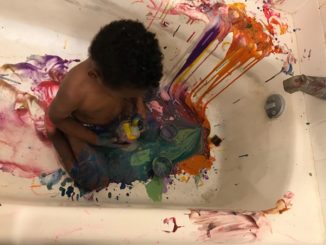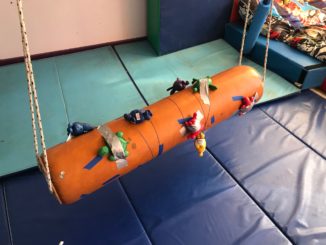On the topic of process art vs product art.
“Product” art is like— doing a craft. There’s supposed to be a set result and everybody’s is supposed to look a set way. Sometimes I hear arguments for the positive side of product art in terms of teaching children specific fine motor skills; i.e., if everybody has to cut out their project in exactly the same way, then they work on cutting, or things like that. Sure, I can see an argument to be made there. I’m not saying crafts are evil. They’re fine. I loved crafts when I was a kid.
“Process” art is what young children (toddlers, preschoolers, early elementary) are drawn to if they’re not interfered with, though. They aren’t thinking about what the end result will look like when they set out—not if they haven’t been acted upon by an adult or other outside force! They might explore the way colors mix on the paper, they might pretend the pencil is a car zooming around the page, they might try to put stickers on the page and then take them back off to see what happens. They might mix materials in creative ways—stick stickers onto wet paint; squeeze out huge globs of liquid glue; try to color on the liquid glue with markers to see what happens. The focus is on the process.
I honestly find process art perfectly sufficient for learning new fine motor techniques too. Kids, in my experience, have just as much fun (if not more) and learn just as much (if not more) using the scissors to cut out whatever they’re imagining or processing or whatever weird material I’ve set in front of them — leaves from outside, wet noodles, dry noodles, straws, paper scraps — as they do cutting out a set craft material.
“What about waste?” people commonly ask me. “You say that you let kids learn how to glue by just squeezing out glue and not telling them any different, but isn’t that wasteful?”
Play is learning, and learning isn’t wasteful. It’s OK to preemptively only set out what materials you’re OK with them using all of. Put half the bottle of glue away, in a different container, to be returned to the white bottle after you’re done; or put only a bit of it out, in a cup with a paintbrush, or mix it with a bit of water or paint to stretch it, or involve the child in the exploring.
Ask yourself before entering into an art/play exploration: what would I be okay with them literally using one hundred percent of? Only give them access to that much of everything. Kids can be creative within limitations — some of the best art comes from working within boundaries!




